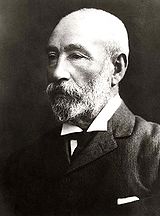Waite, Peter - I973: Difference between revisions
m (1 revision) |
m (moved Peter Waite (philanthropist) to Peter Waite: Philanthropist disambiguation not needed) |
(No difference)
| |
Revision as of 14:31, 11 July 2010

Peter Waite (9 May 1834 – 4 April 1922)[1] was a South Australian pastoralist and public benefactor. Waite's philanthropic endeavors provided significant benefit to the University of Adelaide and to local public schools, and generations of students have benefited from his largesse.
Early life
Waite was born at Kirkcaldy, Fife, Scotland, son of James Waite, a farmer, and his wife Elizabeth, née Stocks. Waite was left fatherless and after leaving school he was apprenticed to an ironmonger[1] and spent nine years in commercial pursuits. Waite then sailed to Australia aboard the British Trident, landed at Melbourne and went on to South Australia.[1] There he joined his brother James who was part owner of Pandappa station near Terowie. Waite worked on this station for some years and acquired a thorough knowledge of the pastoral industry. Waite then (in conjunction with Sir Thomas Elder) bought Paratoo station, and gradually obtained interests in other properties.[2] He was one of the first to realize the value of fenced as against open runs, and spent over £200,000 in fencing and providing water.
On 21 November 1864 Waite married his first cousin Matilda Methuen (d.1922)[1] a daughter of James Methuen of Leith, Scotland,[2] together they had eight children.[1] For many years he lived in the country and kept a strict eye on the management of his various properties. Later he was able to hand over much of this management to his son, while he conducted business in Adelaide. He thoroughly understood the needs of pastoralists, and in 1885 the business of Elder Smith and Company was formed at Adelaide to arrange for their supplies and manage the disposal of their wool and sheep.[2] Waite was elected chairman of directors of the new company and held the position for 37 years, resigning only a few months before his death. The development of this company owed much to Waite's acumen and foresight.[2]
Philanthropic efforts
In 1913 Waite presented to the University of Adelaide his valuable Urrbrae estate comprising 134 acres (54 hectares) and house, to which in 1915 was added the adjoining Claremont and Netherby estates of {{safesubst:#invoke:convert|convert}}. Benefactions to the University of Adelaide allowed the university to establish the Waite Agricultural Research Institute which later became the Waite Campus of the university.[3] The Waite Institute was established on the site in 1924 following a bequest of Urrbrae House and {{safesubst:#invoke:convert|convert}} from Waite.
The donation remains one of the largest public benefactions in South Australian history.[3] The objective of the bequest was to advance the cause of education and more especially to promote the teaching and study of agriculture, forestry and other related subjects.[2] The Waite Institute has developed into an integrated research and teaching precinct that has been presented as a model for the collocation of agricultural research institutions.
Waite also gave an adjoining estate of {{safesubst:#invoke:convert|convert}} to the government of South Australia for the purpose of founding an agricultural high school: Urrbrae Agricultural High School.[1] Waite was working until a few months before his death from heart failure on 4 April 1922; he was survived by his wife and four children.[1] One of his daughters, Elizabeth Macmeikan (died 5 April 1931), left the residue of her estate, some £16,000, to the University of Adelaide to be used for the study of sciences relating to the land, either in connexion with the Waite Research Institute or otherwise.
References
External links
- Waite Campus of the University of Adelaide
- Waite, Peter (1834 - 1922)', Australian Dictionary of Biography